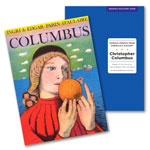We usually think of the colorful d’Aulaire books that are published by Beautiful Feet Books as appropriate for younger children. However, when it comes to independent reading, the d’Aulaire biographies are relatively lengthy and use a vocabulary that makes them most appropriate for students in the middle elementary grades up through junior high. Capitalizing on that, Blackbird & Company have created a series of Famous People from America’s History Research Discovery Guides covering each of the d’Aulaire biographies for Leif the Lucky, Pocahontas, Christopher Columbus, George Washington, Benjamin Franklin, Abraham Lincoln, and Buffalo Bill. The d’Aulaire books provide the content while each guide walks students through the creation of a biographical essay as they study each book. Thus, students learn quite a bit about the person they are studying while also practicing reading comprehension and writing skills.
These guides will probably work best with students in grades four through six, but you can profitably use them with students up through junior high as well. The guides are designed primarily for independent study, so they are written directly to the student. A parent or teacher should go over the pages of the introduction with the student to help them understand the structure of the guide, the elements of each lesson, and the techniques for writing their essays. At the end of the introduction are grading guidelines that will be useful for both students and teachers.
Lessons are highly structured to support students through the process. Each guide divides the companion d’Aulaire book into sections so that students read a section then write about that period of the person’s life. After writing the body of the biographical essay, they write their opening and closing.
For example, in the guide for Christopher Columbus that I reviewed, there are five sections. The first three sections break the book (and Columbus’ life) into three chronological parts.
In the first part, students read about Columbus’ early life up to 1492. They then explore and write about character traits, first defining them then writing about them in terms of the historical figure. A series of comprehension questions stimulates students to think about the context, major events, motivations, and other story elements that might be incorporated into their papers. Students are then ready to construct their first paragraph, beginning with five sentences they derive from a brainstorming process. They will then add an introductory and a concluding sentence to complete the paragraph.
In the same fashion, they will read the next two sections of the book then construct the second and third paragraphs.
Section four of the guide helps students write an opening paragraph with a hook, a context sentence, and a thesis sentence. Next they write the closing paragraph including a weave, an echo, and a twist. (The guide explains what each of these terms mean.)
Students then have only to combine all of these sections into their final essay.
After students write their first draft of each section of their essay, the guide directs them to “conference” with a parent or teacher for guidance. Some students might need even more guidance at earlier stages in the writing process, so be prepared to help them as needed.
Section five of the guide offers ten suggestions for a culminating project. These stretch into other modes of learning with ideas such as “Create a visual timeline of Columbus’ voyages,” “Research the common foods of Columbus’ time and make a recipe book,” and create a papier mâché globe and paint it as Columbus envisioned it. (A few of these suggestions are repetitive of each other.)
Summary
Using the D’Aulaire books in this fashion seems like a brilliant idea. The books have great content, but they are easily manageable for the student who is just learning to summarize content from books. Breaking the process down into sections helps even more. While the process is highly structured, The Research Discovery Guides still allow opportunities for students to select their own highlights from the story and develop their own ideas about character traits, motivation, and other aspects they might include in their essay.
You can purchase bundles of the guide and the companion D’Aulaire book or purchase only the guides if you already have access to the D’Aulaire books.








